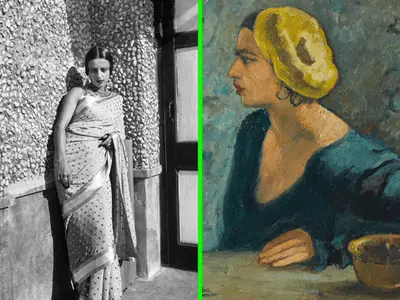
Throughout history, we witnessed several artworks portraying an artist’s love towards their nation. From Bharat Mata by Abanindranath Tagore to Haripura Posters- a collection of 84 paintings by Nandalal Bose, a viewer can translate patriotism everywhere. But it only happened once when an artist declined several opportunities, and when asked about it, her reply was,
Europe belongs to Picasso, Matisse, Braque and many others. India belongs only to me
Amrita Sher-Gil is a 20th-century Hungarian-based Indian painter whom the world calls Frida Kahlo of India. She was the elder daughter of Umrao Singh, a Sikh aristocrat and a scholar in Persian and Sanskrit and Marie Antoniette Gottesmann, a Hungarian Jewish opera singer.

She was known to be involved in several controversies, starting with her dismissal from a convent school when she called herself an atheist.
Shergill started painting at the age of five, the same time when she moved to India with her family. Her artworks used to be extraordinary, but it was only Ervin Bakhtay, whom she was niece, who noticed her talent in 1924 during his visit to Shimla and started inspiring her to pursue art. Through repeated criticisms, he made her build an academic foundation. She used to paint the servants of her home and model them for the same.

Amrita’s mother, Marie, always wanted her to pursue art in Italy, where great artists learned. So, in 1923, she took her to Italy and enrolled her in a school. On the contrary, Shergill’s traits of nation’s love started to appear, which made her return to India in just a year.
Exposed to Italian mastery, she started practising art at home. At 16, she moved to Europe again and trained at Académie de la Grande Chaumière and then at the École des Beaux-Arts.
In Paris, critics called her too mature for her art but ignoring them, the artist continued the journey, practised Bohemian circles in Paris and in 1932, gained global recognition with her first oil painting, Young Girls.
She also became the youngest member of the Asian Associate of the Grand Salon of Paris.

While her career was peaking, Amrita Sher-Gil developed the desire to return to India, and she did in 1934.
After her return, the artist travelled the country, exploring Pahari, Mughal, and cave paintings at Ajanta.
Inspired by the same, she painted Indian classical artworks like Brahmacharis and South Indian Villagers going to market. The paintings depicted the use of colours to showcase poverty and despair. It was also the time when she wrote in a letter to her friend that she wanted to only be in India.

When Amrita Sher-Gil was 25, she married Dr Victor Egan, and together they moved to her paternal family home in Saraya, Gorakhpur. Here she took inspiration from Rabindranath Tagore, Abanindranath Tagore, and Jamini Roy to obtain art colours that were bright and rich. Before this period, her paintings lacked the use of shades like deep reds. One of the famous artworks she painted here was In the Ladies’ Enclosure which auctioned for Rs. 37.8 Cr in 2021 by Saffron art.

Amrita’s family used to have strong ties with the British Raj, but she called herself an admirer of Mahatma Gandhi and a Congress sympathiser. In 1940, when Amrita was in Saraya, Jawaharlal Nehru, an old friend, visited. It is said, that both exchanged letters for a time which were burnt by the former’s parents before marriage. Nehru found Shergil too good-looking, and so did Amrita, but even then, she never portrayed him by saying that he was,
too good looking
At age 28, Amrita Sher-Gil prepared for the first major solo show in Lahore, before which she became seriously ill and slipped into a coma. Later at midnight, she took her last breath. After the incident, Shergill’s mother, Marie, accused Egan of murdering her through a failed abortion. Following the same, Britain declared a war on Hungary and Egan became an enemy alien.
Though she lived little, her life was a sip of talent and freedom. Before dying, she left behind numerous artworks which the government of India called National Treasure. This is the last painting that Amrita was working on:

As I thought about her, I just wanted to conclude by saying that there used to be people who lived and loved India when we longed for westernism.

























